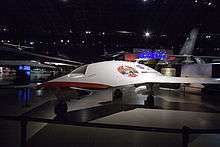Joint Unmanned Combat Air Systems

Joint Unmanned Combat Air Systems, or J-UCAS, was the name for the joint U.S. Navy and U.S. Air Force unmanned combat air vehicle procurement project. The two vehicles involved in the project were the Boeing X-45 and Northrop Grumman X-47. J-UCAS was managed by the Defense Advanced Research Projects Agency. In the 2006 Quadrennial Defense Review, it was stated that the J-UCAS program would be terminated and instead a new long-range strategic bomber program, "Next-Generation Bomber", for the Air Force has been launched.[1] The program was revitalized into a Navy-only program named UCAS-D.[2]
History
It is unusual for DARPA to be involved with advanced development programs; the agency normally performs proof-of-concept demonstrations and then hands follow-on programs on to interested military services. Apparently this arrangement was driven from the office of the secretary of defense, the idea being that DARPA would be able to keep the development effort on track until advanced demonstrators were available, and then the program would have so much momentum that it would keep on going. The long list of US military UAV programs that have been bungled and dropped after much expense and effort, with some of them like the Hunter ending up effectively reaching operational service in spite of it, provoked the decision.
Of course, the candidates for the J-UCAS program included developments of the follow-ons to the Boeing X-45A and the Northrop Grumman X-47 Pegasus. DARPA and Boeing had been working on the "X-45B", a scaled-up X-45A that was seen as the prototype for an operational machine that would reach service in 2008, and would carry a 1,590 kilogram (3,500 pound) warload to a combat radius of 1,665 kilometers (900 nautical miles). Two were to be built, but before any metal could be bent for the two X-45B prototypes planned, the Air Force redirected the effort to an even more capable machine, the "X-45C".
The X-45C, as currently envisioned, will be a flying wing powered by a single F404-GE-102D turbofan engine. Current specs include:
The payload and range specifications are as defined by J-UCAS requirements. The operational radius specification is for a strike to a predefined target and back home again. A secondary range specification dictates a two-hour loiter capability at a radius of 1,850 kilometers (1,000 NMI).
Partly because of the pressure from Boeing, in the summer of 2003, Northrop Grumman formed an alliance with Lockheed Martin to help develop the "X-47B", a follow-on to the X-47 that would compete against Boeing efforts. The alliance, which repeats the successful teamup that won the F-35 Joint Strike Fighter effort, is focused on building a modular stealthy UCAV that could be adapted to a wide range of missions. It would have a speed of Mach 0.8 at 10,670 meters (35,000 feet) and endurance of up to 12 hours.
The goal of the J-UCAS effort is to select a single contractor to provide from 10 to 12 machines for operational evaluation in the 2007-2008 time frame. Current plans are to obtain two X-45Cs and two X-47Bs to perform a comparative evaluation and then select a winner for development in the 2010 time frame.
Specifications for the J-UCAS are still evolving. Right now, both services envision a stealthy machine with a pricetag of $10 to $15 million USD, which is actually modest for a sophisticated stealthy combat aircraft. The USAF envisions that J-UCAS will feature:
- Stores pylons on the wings for external fuel tanks or additional munitions.
- Mid-air refueling capability.
- A narrow field-of-view SAR-MTI system for targeting and post-strike damage assessment.
The USAF has envisioned an operational UCAV as being stored in broken-down form inside a container that can be airlifted, with the UCAV having a specified "shelf life" of 20 years. It would be removed from the container every few years for inspections and could be checked with an electronic test system. The Air Force would also like to use an operational UCAV as the basis of a "penetrating jammer" platform that would penetrate enemy airspace to blind hostile radars. It would replace the Grumman EA-6B Prowler manned electronic warfare aircraft in this role. A reconnaissance payload is also being considered. However, the Air Force wants to focus on the strike role first.
Over the long term, the Air Force is interested in using a UCAV as a platform to carry directed-energy weapons, initially a "high power microwave (HPM)" weapon to fry adversary electronic systems. The HPM weapon would be "fired" out an aperture on the front of the aircraft, with electronic steering used to direct the beam over an arc covering about 45 degrees to either side of the UCAV. The HPM weapon could be followed by a high power laser weapon.
The Navy is interested in many of the features on the Air Force wish list, though the Navy has put reconnaissance and jamming at the top of the list and strike at the bottom, and seems to be indifferent to the containerization concept. Of course, a navalized UCAV would have a stronger airframe and landing gear for carrier takeoffs and landings; an arresting hook; and avionics for automated carrier approach and landing, along with a "relative navigation system" that will tell the UCAV where it is relative to the carrier.
A big concern of program officials is to ensure that widespread use of UCAVs does not increase the number of friendly fire incidents or collateral damage to civilian targets. The evaluation program will investigate this matter in detail. One of the concepts now being given considerable thought is use of a manned aircraft, such as an F-15E Strike Eagle, as a UCAV "mothership", with the weapons systems officer in the back seat directing one or more UCAVs over high-speed datalink.
References
- ↑ "Pentagon Sets Plan For New Bomber, Terminates J-UCAS Program", GlobalSecurity.org, 13 January 2006
- ↑ "Carrier UCAVs: The Return of UCAS", Defense Industry Daily, 7 February 2010